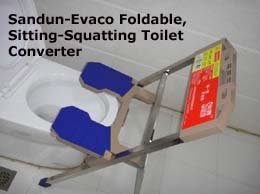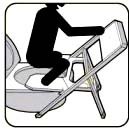|
|
Twelve Most Commonly Asked Questions About Squatting
Like many visitors who first came across the information on the benefits of squatting and health hazards of sitting toilets on this site, you may have several questions on your mind.
The twelve most common and frequently asked questions, and the answers to these questions, are listed below.
 Find Out More...
Find Out More...
|
1.
|
If squatting is so natural and important for health, why have the Western world and many other nations abandoned this practice?
Although squatting is the most natural and effective posture for evacuation, a person can also use other positions when needed, eg: a sprained or broken leg. For thousands of years, kings and queens, the rich and powerful have chosen to make use of this option to be 'different' and distinguish themselves from the 'commoners' or native people in the colonies. However, it was actually in the mid 19th century that sitting toilets really took off. It was the beginning of the Industrial Revolution. For the very first time, indoor plumbing became universally available. The early inventors and industrialists had decided - rather arbitrarily - to install seated water closets everywhere. They could have chosen to introduce squatting toilets, as these could also be used with the sewer piping system. But in a quirk of history, it was not to be…
Knowing nothing about physiology, the toilet inventors sincerely believed they were improving people's lives. The throne-like toilets would allow ordinary people to do it 'differently' from natives who squatted, and also make them feel like kings and queens. Those who felt uncomfortable with this development were forced to keep silent. (In Victorian England, bodily functions were considered unmentionable.) So from Great Britain, the most influential country in the world at the time, the fad quickly spread to the rest of Europe, North America, Australia and many developing countries. No country wanted to seem "backward" at a time when the world was making such rapid "progress". Not long ago, the taboo surrounding this subject kept most of the Western world in the dark about how the human body was designed to function. Even today, not many are aware that the sitting toilet poses a serious threat to their health. The continuing failure of the medical profession to educate people is especially regrettable. The situation has caused much needless pain and suffering. [Back to Top]
|
|
2.
|
Does it really matter whether I sit or squat? What is the big difference, if any, between the two toileting postures?
When a person squats, his or her thighs are pressed against the lower abdomen. The action of the thighs support and colon and causes the pressure inside the abdominal cavity to increase. The resulting natural pressurization of the colon facilitates waste evacuation. In the squatting position, the pelvis is also suspended like a cradle, and the buttock opens up to expose the anus. Squatting also do what sitting cannot do: it "releases " the kink in the anal canal . This straightens the final pathway between the rectum and the anus, making it easy for waste to pass out easily and completely. However, in the sitting position, the kink (bend) between the rectum and anal canal is not released. The abdomen (and colon) is also deprived of any support from the thighs. As a result, a person using the seated posture for defecation is forced to hold the breath and strain and push downwards for waste evacuation. Yet evacuation can never be complete, resulting in accumulation and hardening of residual wastes in the lower regions of the colon. All these things – opening of the buttocks, straightening of the anal canal, beneficial increase in pressure in the abdomen and hence compression of the colon – can only take place in the squatting position. The result is easier, faster and more complete bowel movements. [Back to Top]
|
|
3.
|
Will squatting cure my constipation?
The repeated use of the sitting toilet results in, or aggravates, many common conditions, such as constipation. Many people have found much improvement in their constipation condition the moment they change from sitting to squatting. If no congenital factors are present and the colon has no physical defects, squatting – combined with adequate dietary fiber and drinking lots of water - will provide rapid relief from constipation. It doesn't just apply to constipation. Squatting has also been found to improve haemorrhoid conditions within seven days. Children with bed-wetting problems have been known to attain normal control after a few weeks. There is a decrease in the risk of bladder infections in women who squat to urinate. Also, women with bladder weakness and incontinence can regain normal control after about three months of squatting. Men with uncomplicated lower urinary tract symptoms often improve after three months, and regain normal function after six months. [Back to Top]
|
|
4.
|
Well, I don't have any problems with elimination in the sitting position. Why must I bother about squatting?
Just as a person can get 'used' to tight fitting shoes etc, one can also get 'used' to sitting for defecation. However, the price for persisting in this seemingly harmless habit can be high, when colon and pelvic-related health problems begin to manifest themselves ten, twenty or thirty years down the road. By then, it may be too late to do anything about it, eg: acute appendicitis, colon cancer. [Back to Top]
|
|
5.
|
Can't I get the same benefits of squatting with a sitting toilet by using a foot stool to raise up my legs and bring my knees closer to my body?
Having a squatting toilet is best. Using a stool to elevate the feet and bring the knees towards the body is not the same as squatting. It is merely a crude attempt to imitate the natural squatting position where the entire weight of the upper body is on the feet, and the thighs are in contact with and pressed against the lower abdomen (see diagram).
The resulting increase in pressure of the abdominal cavity and beneficial compression of the colon results in comfortable and complete evacuation. With a squatting stool, you still have to bend forward and use the awkward posture in an attempt to make contact with the thighs and compress the colon (see diagram).
This pseudo squatting posture is not the same as the natural squatting posture. You would still need to hold the breath and strain to push downwards to evacuate – which is not required when squatting correctly. Straining in this way is the cause of hemorrhoids, diverticulosis and pelvic floor prolapse. Dr B. A. Sikirov, the Israeli physician who conducted successful clinical tests on the use of squatting to cure hemorrhoids (more on this study), found that the full benefits of squatting can only be achieved in the natural squatting position. [Back to Top]
|
|
6.
|
I want to squat but don’t have any squatting toilet at home. What can I do?
If you don't have a squatting toilet but you want to squat, you have, practically speaking, four options. You can install a new squatting toilet. You can replace an existing sitting toilet with a squatting type. (These two options are often not feasible because of different plumbing requirements, building regulations or high cost.) The third option is to construct a metal structure over your sitting toilet (see this real-life example).
The fourth – possibly the most practical option for most – is to use a toilet squatting platform (picture). (Click here for more information about toilet squatting platform.) [Back to Top]
|
|
7.
|
Why do I need a toilet squatting platform? Can't I just squat on the toilet bowl?
Attempting to balance and squat on top of the toilet bowl is not only difficult, but dangerous and risky. Most standard toilet bowls are not designed to allow squatting on the rim of the bowl, or to bear the weight of someone squatting on it (especially someone heavy). They have been known to give way and collapse, causing severe injury from pieces of jagged porcelain. [Back to Top]
|
|
8.
|
Is a toilet squatting platform easier to use than a traditional squat toilet?
A toilet squatting platform would be just as good as having a traditional squat toilet. It will allow you to adopt the natural squatting position, albeit at a height of 41 cm (16 inches) above the floor, over a sitting toilet (see diagram). [Back to Top]
|
|
9.
|
What are the pros and cons of a toilet squatting platform?
A toilet squatting platform will save you all the hassle and high cost of installing a squatting toilet.
The only "disadvantage" (if you want to call it), is that a user must be capable of squatting (for 5 minutes, or what you would need to evacuate). Also, s/he must not suffer from fainting spells or have a poor sense of balance, which can lead to falling off the platform. [Back to Top]
|
|
10.
|
Can the elderly use a toilet squatting platform? How about small children?
Squatting is for all – young or old. If you are able to squat without discomfort, regardless of your age, you can use a toilet squatting platform. However, if you have any feeling of unsteadiness or a tendency to lose your sense of balance, then you should not use it. For those who are able to use a toilet squatting platform, it doesn't hurt either to take additional safety precautions. Either attach hand grips to the wall, or set a chair in front of the toilet (facing away) so you can hold onto the back of the chair. If not for potties, young children would instinctively squat to answer the call of nature. Wrong toileting posture actually has a greater impact on children. Because of their shorter legs, their feet may not be able to touch the floor when they are on a sitting toilet. Unlike an adult who can somewhat mitigate the effects of sitting by leaning their body forward towards their raised knees (and thighs) to mimic the squatting position, children can't. Their colon is left totally deprived of any support from the thighs.
For this reason, children should especially be encouraged and allowed to squat. However, they should use a toilet squatting platform with close adult supervision. It is best to let them hold on to a chair (or walker if space is tight) for additional support. If you are really concerned about having your toddler squat but not above a sitting toilet, you can place two bricks at the sides of a bedpan-like container. They can step up onto the bricks and squat over the container. [Back to Top]
|
|
11.
|
On a toilet squatting platform, can I urinate as well?
Yes. Squatting is an excellent posture for urination. For men though, it may be necessary to aim downwards (hold and guide with hands if necessary). For women, it is even easier because their urethra naturally points downwards. [Back to Top]
|
|
12.
|
What will happen to sitting toilets if everyone decides to switch to squatting?
Not all should be consigned to the scrap yard. Perhaps a few could be salvaged for display in museums and schools, to serve as a reminder of the danger and folly of choosing form over function. And as an example of a modern 'innovation' which have caused more harm than good. (A few other examples that come to mind: microwave ovens, leaded petrol, CFCs, aluminium and Teflon-coated cooking utensils, mercury dental fillings.) [Back to Top]
|
Why Squatting Is Better Than Sitting
The 9 Benefits of Squatting
Go from Questions about Squatting to Home Page
Have A Great Story About This Topic?
Do you have a personal account about the topic discussed on this page? Please consider sharing it. You can be sure that many people in the world would love to read about and greatly benefit from your experience. It's easy to do. Just let your words flow. Thanks for sharing!
What Other Visitors Have Said
Click below to see contributions from other visitors to this page...
|
|
|












